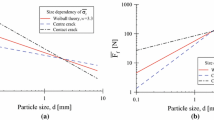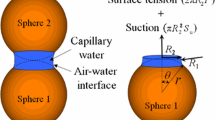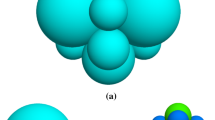Abstract
We use a recent reformulation of the Breakage Mechanics theory explaining comminution in wet granular assemblies. By using a dataset for sands, we quantify the relation between a geometric descriptor of the assembly (i.e., the mean grainsize) and the model constants that control the suction air-entry value and the stress threshold at the onset of crushing. Such relations are used to define two contrasting scenarios for the coupling between degree of saturation and yielding. In the first scenario, the suction air-entry value scales inversely with the mean grainsize, while the energy input for comminution is assumed to be independent of the size of the particles. The outcome of this assumption is that changes in degree of saturation are predicted to play a more intense role in finer gradings. Conversely, if we assume that also the energy input for grain breakage scales inversely with the size of the particles, the effect of the degree of saturation is predicted to be stronger in coarser assemblies. In other words, the deterioration of the yielding stress due to grainsize scaling effects is predicted to exacerbate the water sensitivity of unsaturated crushable soils. This result provides an interpretation for the evidence that solid–fluid interactions have a noticeable role in the compression response of assemblies made of coarse brittle particles (e.g., gravels or rockfill), while they tend to play little or no role in granular materials characterized by a finer grading (e.g., sands).















Similar content being viewed by others
References
Nakata, Y., Kato, Y., Hyodo, M., Hyde, A.F., Murata, H.: One-dimensional compression behaviour of uniformly graded sand related to single particle crushing strength. Soils Found. 41(2), 39–51 (2001)
Lade, P.V., Yamamuro, J.A., Bopp, P.A.: Significance of particle crushing in granular materials. J. Geotech. Eng. 122(4), 309–316 (1996)
Hardin, B.O.: Crushing of soil particles. J. Geotech. Eng. 111(10), 1177–1192 (1985)
Chuhan, F.A., Kjeldstad, A., Bjørlykke, K., Høeg, K.: Experimental compression of loose sands: relevance to porosity reduction during burial in sedimentary basins. Can. Geotech. J. 40(5), 995–1011 (2003)
Zoback, M.D., Byerlee, J.D.: Effect of high-pressure deformation on permeability of ottawa sand. AAPG Bull. 60(9), 1531–1542 (1976)
Papamichos, E., Vardoulakis, I., Ouadfel, H.: Permeability reduction due to grain crushing around a perforation. Int. J. Rock Mech. Min. Sci. abstr. 30, 1223–1229 (1993)
DeJong, J.T., Christoph, G.G.: Influence of particle properties and initial specimen state on one-dimensional compression and hydraulic conductivity. J. Geotech. Geoenviron. Eng. 135(3), 449–454 (2009)
Arya, L.M., Paris, J.F.: A physicoempirical model to predict the soil moisture characteristic from particle-size distribution and bulk density data. Soil Sci. Soc. Am. J. 45(6), 1023–1030 (1981)
Yang, H., Rahardjo, H., Leong, E.C., Fredlund, D.G.: Factors affecting drying and wetting soil–water characteristic curves of sandy soils. Can. Geotech. J. 41(5), 908–920 (2004)
Jamei, M., Guiras, H., Chtourou, Y., Kallel, A., Romero, E., Georgopoulos, I.: Water retention properties of perlite as a material with crushable soft particles. Eng. Geol. 122(3), 261–271 (2011)
Alonso, E.E., Gens, A., Josa, A.: A constitutive model for partially saturated soils. Géotechnique 40(3), 405–430 (1990)
Gallipoli, D., Gens, A., Sharma, R., Vaunat, J.: An elasto-plastic model for unsaturated soil incorporating the effects of suction and degree of saturation on mechanical behaviour. Géotechnique 53(1), 123–136 (2003)
Gens, A.: Soil-environment interactions in geotechnical engineering. Géotechnique 60(1), 3–74 (2010)
Oldecop, L.A., Alonso, E.E.: A model for rockfill compressibility. Géotechnique 51(2), 127–139 (2001)
Oldecop, L.A., Alonso, E.E.: Suction effects on rockfill compressibility. Géotechnique 2, 289–292 (2003)
Alonso, E.E., Olivella, S., Hugas, J.: Modelling the behaviour of an earth and rockfill dam during construction and impoundment. Unsat. Soils: Numer. and Theor. Approach., pp. 269–287. (2005)
Heath, A.C., Pestana, J.M., Harvey, J.T., Bejerano, M.O.: Normalizing behavior of unsaturated granular pavement materials. J. Geotech. Geoenviron. Eng. 130(9), 896–904 (2004)
Frey, R.G., Halloran, J.: Compaction behavior of spray-dried alumina. J. Am. Ceram. Soc. 67(3), 199–203 (1984)
Nieuwmeyer, F.J., van der Voort Maarschalk, K., Vromans, H.: Granule breakage during drying processes. Int. J. Pharm. 329(1), 81–87 (2007)
Maatouk, A., Leroueil, S., La Rochelle, P.: Yielding and critical state of a collapsible unsaturated silty soil. Géotechnique 45(3), 465–477 (1995)
Cui, Y., Delage, P.: Yielding and plastic behaviour of an unsaturated compacted silt. Géotechnique 46(2), 291–311 (1996)
Romero, E., Della Vecchia, G.: An insight into the water retention properties of compacted clayey soils. Géotechnique 61(4), 313–328 (2011)
Oldecop, L.A., Alonso, E.E.: Theoretical investigation of the time-dependent behaviour of rockfill. Géotechnique 57(3), 289–301 (2007)
Chávez, C., Alonso, E.E.: A constitutive model for crushed granular aggregates which includes suction effects. Soils Found. 43(4), 215–227 (2003)
Soulie, F., Cherblanc, F., El Youssoufi, M.S., Saix, C.: Influence of liquid bridges on the mechanical behaviour of polydisperse granular materials. Int. J. Numer. Anal. Methods Geomech. 30(3), 213–228 (2006)
Richefeu, V., El Youssoufi, M.S., Radjai, F.: Shear strength properties of wet granular materials. Phys. Rev. E 73(5), 051,304 (2006)
Alonso, E.E. and Romero, E.: Collapse behaviour of sand. Proc. Of the 2nd Asian Conf. on Unsat. Soils (2003)
Houlsby, G.: The work input to an unsaturated granular material. Géotechnique 47(1), 193–196 (1997)
Gili, J.A., Alonso, E.E.: Microstructural deformation mechanisms of unsaturated granular soils. Int. J. Numer. Anal. Methods Geomech. 26(5), 433–468 (2002)
Li, X.S.: Effective stress in unsaturated soil: a microstructural analysis. Géotechnique 53(2), 273–277 (2003)
Scholtès, L., Chareyre, B., Nicot, F., Darve, F.: Micromechanics of granular materials with capillary effects. Int. J. Eng. Sci. 47(1), 64–75 (2009)
Fisher, R.: On the capillary forces in an ideal soil; correction of formulae given by wb haines. J. Agric. Sci. 16(03), 492–505 (1926)
Oda, M., Iwashita, K.: Mechanics of granular materials: an introduction. A.A.Balkema, Rotterdam (1999)
Einav, I.: Breakage mechanicspart I: theory. J. Mech. Phys. Solids 55(6), 1274–1297 (2007)
Einav, I.: Breakage mechanicsł part II: modelling granular materials. J. Mech. Phys. Solids 55(6), 1298–1320 (2007)
Einav, I.: Fracture propagation in brittle granular matter. Proc. Roy. Soc. Lond. Ser. A 463(2087), 3021–3035 (2007)
Buscarnera, G., Einav, I.: The yielding of brittle unsaturated granular soils. Géotechnique 62(2), 147–160 (2012)
Collins, I.F., Houlsby, G.T.: Application of thermomechanical principles to the modelling of geotechnical materials. Proc. Roy. Soc. Lond. Ser. A 453(1964), 1975–2001 (1997)
McDowell, G.R., Bolton, M.D.: On the micromechanics of crushable aggregates. Géotechnique 48(5), 667–679 (1998)
Nguyen, G.D., Einav, I.: The energetics of cataclasis based on breakage mechanics. Pure Appl. Geophys. 166(10–11), 1693–1724 (2009)
Einav, I., Puzrin, A.: Pressure-dependent elasticity and energy conservation in elastoplastic models for soils. J. Geotech. Geoenviron. Eng. 130(1), 81–92 (2004)
Lloret, A., Alonso, E.E.: Consolidation of unsaturated soils including swelling and collapse behaviour. Géotechnique 30(4), 449–477 (1980)
Flavigny, E., Desrues, J., Palayer, B.: Note technique-le sable d’hostun “rf”. Revue française de géotechnique 53 (1990)
Daouadji, A., Hicher, P.Y., Rahma, A.: An elastoplastic model for granular materials taking into account grain breakage. Eur. J. Mech. A-Solid 20(1), 113–137 (2001)
Lins, Y., Schanz, T.: Determination of hydro-mechanical properties of sand. Unsat. Soils: Exp. Studies, pp. 15–32. (2005)
Lloret, A., Villar, M.V., Snchez, M., Gens, A., Pintado, X., Alonso, E.E.: Mechanical behaviour of heavily compacted bentonite under high suction changes. Géotechnique 53(1), 27–40 (2003)
Loret, B., Khalili, N.: An effective stress elastic–plastic model for unsaturated porous media. Mech. Mater. 34(2), 97–116 (2002)
Gens, A., Sánchez, M., Sheng, D.: On constitutive modelling of unsaturated soils. Acta Geotech. 1(3), 137–147 (2006)
Terzaghi, K., Peck, R., Mesri, G.: Soil Mechanics in Engineering Practice. Wiley, New York (1996)
Kovács, G.: Seepage Hydraulics. Elsevier, Amsterdam (1981)
Stormont, J.C., Anderson, C.E.: Capillary barrier effect from underlying coarser soil layer. J. Geotech. Geoenviron. Eng. 125(8), 641–648 (1999)
Aubertin, M., Mbonimpa, M., Bussière, B., Chapuis, R.: A model to predict the water retention curve from basic geotechnical properties. Can. Geotech. J. 40(6), 1104–1122 (2003)
Einav, I.: Fracture propagation in brittle granular matter. Proc. Roy. Soc. Lond. Ser. A 463(2007), 3021–3035 (2007)
Lee, D.M.: The angles of friction of granular fills. Ph.D. thesis, Cambridge University (1992)
Bruch, P.: A laboratory study of evaporative fluxes in homogeneous and layered soils. M.sc. thesis, University of Sas- katchewan, Saskatoon, Saskatchewan (1993)
De Souza, J.: Compressibility of quartz sand at high pressure. M.sc. thesis, Massachusetts Institute of Technology, Cambridge, Mass. (1958)
Fredlund, M.D., Fredlund, D.G., Wilson, G.: Prediction of the soil-water characteristic curve from grain-size distribution and volume–mass properties. In: Proc., 3rd Brazilian Symp. on Unsat. Soils, vol. 1, pp. 13–23. Rio de Janeiro (1997)
Indrawan, I., Rahardjo, H., Leong, E.C.: Effects of coarse-grained materials on properties of residual soil. Eng. Geol. 82(3), 154–164 (2006)
Lee, K.L., Farhoomand, I.: Compressibility and crushing of granular soil in anisotropic triaxial compression. Can. Geotech. J. 4(1), 68–86 (1967)
Lirer, S., Flora, A., Nicotera, M.: Some remarks on the coefficient of earth pressure at rest in compacted sandy gravel. Acta Geotech. 6(1), 1–12 (2011)
MacKay, P.L.: Evaluation of oxygen diffusion in unsaturated soils. M.sc. thesis, The University of Western Ontario (1997)
Morii, T., Inoue, M., Kadoguchi, R.: Effective water harvesting using capillary barrier of unsaturated soils. Unsat. Soils: Theor. Pract. pp. 857–860 (2011)
Nakata, Y., Hyodo, M., Hyde, A.F., Kato, Y., Murata, H.: Microscopic particle crushing of sand subjected to high pressure one-dimensional compression. Soils Found. 41(1), 69–82 (2001)
Pestana, J.M., Whittle, A.: Compression model for cohesionless soils. Géotechnique 45(4), 611–631 (1995)
Roberts, J.E., De Souza, J.M.: The compressibility of sands. P. Am. Soc. Test Mater. 58(4), 1269–1272 (1958)
Sydor, R.: Engineered mine tailings cover: verification of drainage behaviour and investigations of design. M.sc. thesis, University of Waaterloo (1992)
Acknowledgments
This work has been initiated under a booster fund granted by the Institute of Sustainability and Energy at Northwestern (ISEN) and has been partially supported by grant No. CMMI-1351534 awarded by the Geomechanics and Geomaterials program of the U.S. National Science Foundation.
Author information
Authors and Affiliations
Corresponding author
Appendices
Appendix A: Grading indices for uniform grainsize distributions
If the probability for a given particle of size \(x\) to exist within the interval \((D_m, D_M)\) is assumed to be constant:
it is possible to show that the corresponding cumulative grain size distribution by number is given by:
By further assuming that the mass of each particle \(x\) is proportional to \(x^3\), the cumulative GSD by mass is can be derived as
Then the corresponding probability density function by mass can be derived as
Equation (22) shows good agreement with the initial grading of the commercial sands such as Hostun sand, as shown in Fig. 2. As far as the probability density function of the GSD at complete breakage, it is possible to use the expression suggested by Einav (2007a):
where \(\alpha \) is the fractal dimension (usually set to be 2.7). It is interesting to note that Eq. (23) is a particular case of equation Eq. (24), obtained by setting \(\alpha \) equal to \(-1\).
The grading indices associated with the previously defined GSD curves can be expressed as:
Both indices can be determined by specifing the maximum and minimum particle size (the latter being usually assumed to be 1 mm). In particular, by using Eq. (22) it is possible to express the maximum grainsize \(D_M\) as a function of the mean grainsize \(D_{50}\), as follows:
As a result, the two grading indices given in Eq. (25) can be plotted as a function of \(D_{50}\) (1).
Appendix B: Yield stress upon one-dimensional compression
The vertical stress associated with the onset of comminution upon one-dimensional compression, \({\left( {{\sigma ' _V}} \right) _{CR_{0}}}\) can be computed by enforcing the yielding condition for a \(K_0\) compression path. In this case, the stress path implies that \(q = 3\left( {1 - {K_0}} \right) p'/\left( {1 + 2{K_0}} \right) \) or \({\sigma _v}' = 3p'/\left( {1 + 2{K_0}} \right) \) . Substituting these relations in Eq. (6), the yield stress for a saturated linear elastic medium is given by:
where \({\eta _{K0}} = {{3\left( {1 - {K_0}} \right) } \mathord {\Big /} {\left( {1 + 2{K_0}} \right) }}\). In the case of pressure-dependent elasticity, the yield function can be obtained by combining Eqs. (5),(6) and (11):
where
The \(\left( {{\sigma ' _V}} \right) _{CR_{0}}\) for pressure-dependent elasticity can again be obtained by assuming a \(K_0\) compression path, as follows:
where
The above relations have been used to identify the optimal values of \(E_c\) allowing the mathematical capture of numerous compression experiments available in the literature (Fig. 13).
Rights and permissions
About this article
Cite this article
Zhang, Y.D., Buscarnera, G. Grainsize dependence of clastic yielding in unsaturated granular soils. Granular Matter 16, 469–483 (2014). https://doi.org/10.1007/s10035-014-0491-7
Received:
Published:
Issue Date:
DOI: https://doi.org/10.1007/s10035-014-0491-7




